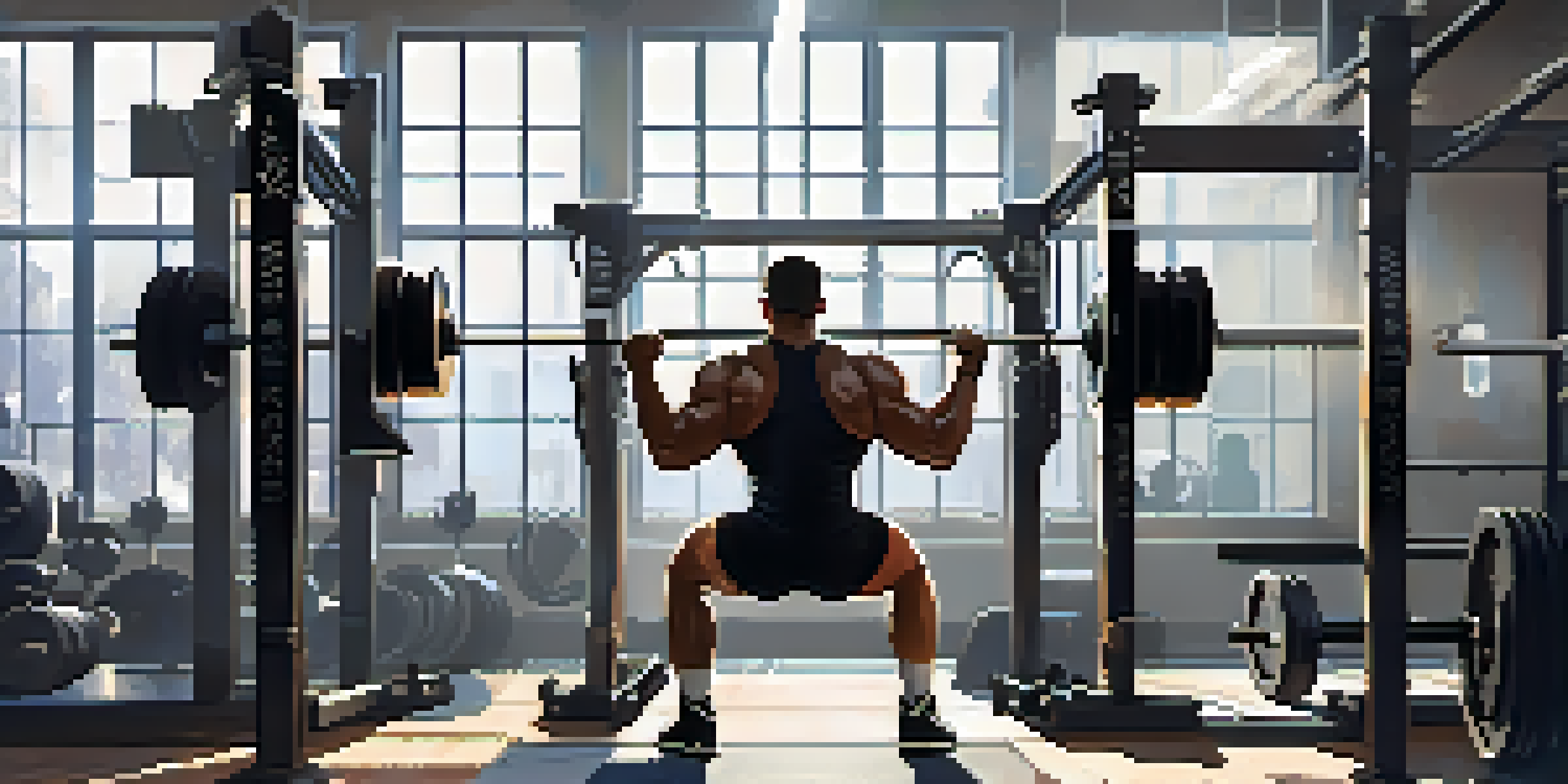Powerlifting Techniques: Enhancing Strength and Composition

Understanding the Basics of Powerlifting
Powerlifting is a strength sport focused on three main lifts: the squat, bench press, and deadlift. Each of these lifts tests different muscle groups and requires specific techniques to maximize performance. Understanding the fundamentals is crucial for anyone looking to enhance their strength and body composition through powerlifting.
Strength does not come from physical capacity. It comes from an indomitable will.
These lifts are not just about raw power; they involve technique, form, and mental focus. For example, proper squatting technique not only helps in lifting heavier weights but also minimizes the risk of injury. Learning the correct form from the start lays the groundwork for consistent progress.
Moreover, powerlifting serves as a fantastic way to track your strength gains over time. As you improve your technique and increase your weights, you'll see tangible results in both your physique and overall fitness. This clear progression can be incredibly motivating, keeping you engaged in your training.
The Importance of Proper Form in Powerlifting
Proper form is essential in powerlifting, as it directly impacts your performance and safety. Each lift has its own set of technical guidelines that, when followed, can lead to optimal strength gains. For instance, in the squat, keeping your weight centered over your midfoot is crucial for balance and power.

Additionally, maintaining a neutral spine during lifts like the deadlift can prevent injuries that might sideline your training. Many lifters benefit from working with a coach or experienced lifter to refine their form, as an outside perspective can highlight areas for improvement. A small adjustment can lead to significant gains.
Mastering Technique is Crucial
Proper form in powerlifting not only enhances performance but also minimizes the risk of injury.
Ultimately, prioritizing form over weight will yield better long-term results. As your body adapts to correct movements, you'll find that lifting heavier becomes easier, and your risk of injury decreases. This approach not only enhances your strength but also contributes to a more balanced physique.
Programming Your Powerlifting Training
An effective powerlifting program balances intensity, volume, and frequency to ensure optimal strength gains. Typically, programs will alternate between focusing on maximum strength and hypertrophy, allowing for muscle growth and recovery. This can involve varying the number of sets and reps you perform each week.
The only way to achieve the impossible is to believe it is possible.
For example, a common approach is to focus on heavy lifting (low reps) one week and switch to higher reps with lighter weights the next. This variation keeps your muscles guessing and promotes continuous progress. It’s important to include accessory exercises that support your main lifts, such as lunges or rows.
Additionally, tracking your progress is essential for any successful program. Keeping a training log can help you identify patterns, celebrate milestones, and adjust your routine as needed. This level of personalization is key to enhancing both strength and body composition.
Nutrition's Role in Powerlifting Success
Nutrition plays a pivotal role in any strength-training regimen, including powerlifting. Consuming the right balance of macronutrients—proteins, carbohydrates, and fats—fuels your workouts and aids recovery. For instance, protein is essential for muscle repair and growth, while carbohydrates provide the energy needed for intense lifting sessions.
Hydration is equally important; being well-hydrated can significantly impact your performance. Many lifters find that tracking their water intake helps them maintain optimum hydration levels, particularly during heavy training periods. Small adjustments to your diet can lead to noticeable improvements in strength and endurance.
Nutrition Fuels Your Progress
A balanced diet and hydration are essential for optimal strength gains and recovery in powerlifting.
Moreover, understanding your caloric needs can help you achieve your body composition goals. Whether you’re looking to bulk up or trim down, a tailored nutrition plan will support your training objectives. Remember, what you put in your body is just as crucial as the weights you lift.
Mental Strategies for Powerlifting Performance
Mental fortitude is just as important as physical strength in powerlifting. Developing a strong mindset can help you push through tough workouts and overcome the inevitable plateaus. Visualization techniques, where you imagine yourself successfully completing a lift, can boost both confidence and performance.
Setting clear, achievable goals can also enhance your focus and motivation. Instead of aiming for an abstract notion of strength, consider setting specific targets for each lift. For example, you might set a goal to increase your squat by 10 pounds over the next month, providing a clear benchmark for your progress.
Finally, embracing the community aspect of powerlifting can provide additional motivation. Joining a local gym or finding a training partner can offer support and accountability, making your training sessions more enjoyable. This shared journey not only enhances performance but also builds lasting friendships.
Recovery Techniques for Optimal Powerlifting Gains
Recovery is an often-overlooked aspect of powerlifting that is essential for long-term success. Your muscles need time to repair and grow stronger after intense lifting sessions. Incorporating rest days into your training schedule allows your body to recover and adapt, ultimately enhancing your performance.
Additionally, active recovery techniques, such as light cardio or mobility work, can help reduce soreness and improve your flexibility. Foam rolling and stretching can also aid in alleviating muscle tightness, ensuring you’re ready for your next session. Finding what recovery methods work best for you can make a significant difference in your training.
Recovery Supports Strength Gains
Incorporating rest and recovery techniques is vital for muscle repair and long-term success in powerlifting.
Sleep is another critical component of recovery. Aim for 7-9 hours of quality sleep each night to support hormone regulation and muscle repair. By prioritizing recovery, you'll find that your strength gains increase and your overall performance improves, setting you up for success in powerlifting.
Common Mistakes to Avoid in Powerlifting
Even seasoned lifters can fall prey to common mistakes in powerlifting that can hinder progress. One such mistake is neglecting accessory work, which supports the main lifts and helps prevent imbalances. Incorporating exercises like shoulder presses or glute bridges can round out your training and improve your overall strength.
Another frequent pitfall is lifting with poor form, often driven by the desire to lift heavier weights. This can lead to injuries that might set you back for weeks or longer. Always prioritize technique over weight, and don’t hesitate to backtrack if necessary to ensure proper form.

Finally, failing to listen to your body can be detrimental. If you're feeling fatigued or in pain, it's crucial to take a step back and assess your training. Ignoring these signals can lead to burnout or injury, ultimately delaying your progress. Remember, powerlifting is a marathon, not a sprint.